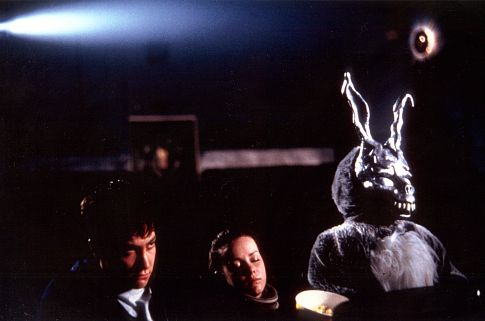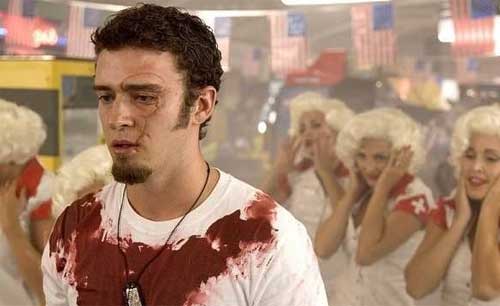Director: David Fincher
Released: 1995Starring: Brad Pitt, Morgan Freeman, Kevin Spacey, Gwyneth Paltrow, John C. McGinley, Richard Roundtree, R.Lee Ermey
Plot: Homicide detectives Somerset (Freeman) and Mills
(Pitt) find themselves pitted against a serial killer using the seven deadly
sins as the basis for a series of gruesome murders.
Review: There is a line towards the end of the film which I
personally feels defines this film.
“What I've done is going to be puzzled over and studied and followed... forever.”
“What I've done is going to be puzzled over and studied and followed... forever.”
While this is kind of a throwaway line
muttered by the sins obsessed serial killer John Doe (Spacey), it is one which
almost encapsulates my love for this film, as even though I have seen it
numerous times it still maintains the same thrills I got the first time I
watched it. So seeing how the folks over at "French Toast Sunday" are holding a month long David Fincher retrospective what better time to revisit than now.
Coming off his loathsome
experience making the fan base dividing “Alien3” few expected this film from
Fincher whom at this point in his career was still better known for directing
music videos than feature films. I would however upon its release soon mark him
out as a talent to watch and one which many had wrongly dismissed with the
release of his feature debut. This film equally forms for myself part of the his most
exciting period of work, which started with “Alien3” and reached its peak with
“Panic Room” before his work started to lose its edge with films like “Zodiac”
and “The Curious Case of Benjamin Button”.
Set in an unnamed city yet
drawing inspiration from New York, it is a morally devoid place which
literally seems to be rotting like an exposed wound with buildings left in a
state of permanent decay while the constant rain only further gives the
impression that it is in some way trying to cleanse itself of the countless
sins it holds within its city limits. All of which makes it the perfect
playground for John Doe to carry out his murderous sermon. It is a landscape perfectly realised by
production designer Arthur Max while only further complimented by the cinematography
of Darius Khondji which sees him drawing inspiration from his earlier work on
“Delicatessen” and “The City of Lost Children”.
While it could be seen as a
hopeless place it is still one which both Somerset refuses to give up on, even
when faced with a society sinking forever further into the depths of depravity.
Of course it could be just that he has become numb to his surroundings, or the
wall of interlect he has built around himself as he keeps an ever quizzical
mind, while frequently proving himself to be well read, something which comes
in especially handy when dealing with a fellow interlect like John Doe. This is
not to say that Somerset doesn’t see his surroundings as he carries in his wallet a picture of a rose which in a deleted scene was shown to have been cut from the wallpaper of a house outside of the city he plans to retire to. Elsewhere his first
conversation with Mills is to question why he would want to transfer there,
especially when it seems everyone is busily trying to get out. Mills of course
though is the polar opposite to Somerset, with Pitt playing him as every bit
the youthful rookie, eager to carve out his career in the big city, which
seemingly is something he feels he couldn’t do in his rural hometown. At the
same time he is hindered by his hot headedness and brash attitude, something
which is frequently played against him by John Doe, something which came as
something of a surprise in many way, especially when Somerset is on a similar
intellectual level let alone as equally well read, but then I guess this would
play against the end game.
Still the odd couple partnership
is nothing new in the crime genre, yet here it still feels fresh, thanks to the
extreme opposites Mills and Somerset are to each other, with Mills just
starting his career while Somerset’s is coming to a close with his retirement
at the end of the week and while the chase to capture John Doe is frequently a
thrilling and shock filled one, it is equally fascinating to see how the case
also brings the two detectives to what could almost be seen as a middle ground
with Somerset losing his zen like cool and slowly showing more aggression and
frustration as John Doe gets closer to completing his masterpiece. Meanwhile
Mills is seen trying to smarten himself up to reach Somerset’s interlectual
level, as he sends out for Cliff notes for the major texts which John Doe
seemingly is drawing inspiration from. The two finally reaching this desired middle
ground as they share a joke while shaving their chests in one of the great
underrated scenes of Fincher’s filmography.
Needless to say it is the murders which overshadow
everything in this film, thanks mainly to them being so memorable, even if like
Mills and Somerset we only get to see the aftermath of John Doe’s handiwork and
with each murder being based around a different sin creative is certainly one
way of describe his work. Of course it is a morbid curiosity going into the
film to see how each of the sins is represented, even if some have now become
more iconic than the film as certainly the case with “Sloth” which finds an
alternative use for car air fresheners. It is of course something of a shock
when we finally meet Spacey’s John Doe, who here continued on from his roll of
playing memorable rolls which he started with “The Usual Suspects” and finished
by playing Lester in “American Beauty” before his rising popularity saw him
taking on more traditional roles. The casting of Spacey though is a great as he
is perfectly able to project the intellect of Doe, while at the same time
carrying the air of doubt around whether he is who he claims to be or if it is
just another game. Of course Fincher plays up such moments giving us more insights into the killer psyche, via John Doe's rambling journals and fractured title sequence than he does actual shots of the man until the very end, which is a gamble which certainly pays off in spades in the memorable finale.
Written by screenwriter Andrew Kevin Walker while on his
daily commute to his then day job at Tower Records, the film really embodies
the distain he felt for New York at the time even if the film never mentions
the name of the city. Sadly while this film would serve to revitalise Finchers’
career after the misfire of “Alien3” this would sadly be to date the high point
of Walker’s career, with his follow up “8MM” falling foul of the studio system,
with director Joel Schumacher siding with the studio over the darker elements of
the script, unlike Fincher who fought to keep the script in tact. Since then he
has mainly worked script rewrites and several shorts aswell as the forgettable
wolfman remake and in many ways becoming a cautionary tale for screenwriters
especially when this script shows so much potential, its sad to see it being
crushed by the studio system. The real genius of the film though is that it is
still as watchable after the 100th time as it was the first time I
saw it, which honestly is something of a rarity for thrillers and when combined
with such memorable visuals and plotting which etch their way into your mind
it truly is an essential watch.























No comments:
Post a Comment